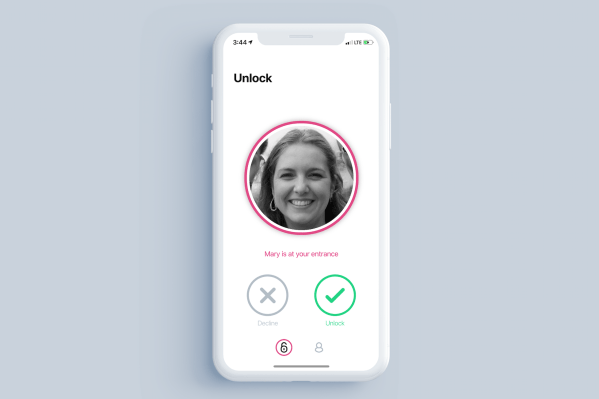If you live in a big city, you’ve probably had your fair share of battles with apartment intercom systems. Those electronic gatekeepers with their tiny screens, sticky buttons, and seemingly endless lists of names to tap through in search of a friend who can buzz you in.
Doorport wants to make those existing systems a bit smarter. They’ve built a device that can be wired into existing buzzer systems, allowing you to use your smartphone to unlock your building’s door for yourself and your guests with a quick tap. Once installed, the existing intercom system works just as it did before — just now with a bit more smarts.
The company’s current prototype hardware is about the size of a deck of cards, and is meant to be tucked into the empty space within an already in-place intercom system. The company’s founders tell me it takes about 5 to 10 minutes to install. You clamp the device onto the inside of the intercom box with a magnet, run two wires for power, and two wires to let the device control the door lock mechanism.
When you open Doorport’s app, it uses Bluetooth to search for nearby doors you have access to. Tapping the on-screen padlock will unlock the door as if you’d scanned your key fob or punched in your code. If a friend arrives with Doorport’s app setup, they’re able to ping you through the app so you can buzz them through the door. When a resident moves out of the building, the property manager just removes that resident’s profile via the admin panel to prevent future access.
The company initially set out to build a full-fledge hardware replacement for existing intercoms, with things like video calling and temporary, single-day access codes. In testing the market, however, they found that landlords weren’t interested in something quite so intense. A whole new system meant ripping out the old hardware, re-training employees, giving all of the residents new key fobs, etc. So they shifted focus to something that sits on top of existing systems, instead.
It’s still pretty early days for the 3-person team. It’s iterating on prototypes, each unit contained within a 3d-printed shell. Just months ago, when the company first got into Y Combinator’s Winter 2019 class, co-founder Reggie Jean-Brice tells me “the hardware was literally on a breadboard.” The device I saw recently, meanwhile, was a sleek little package with “Mark II” emblazoned across the side.
As with most new companies, Doorport is still figuring out exactly how much their product will cost, and are testing different pricing models. Through one model, they’d charge landlords about $350 up front for install, then $1.50 per apartment unit per month. Another model shifts the cost (about $30 a year per unit) to residents, allowing landlords to pitch it as an optional amenity. Co-founder Ben Taylor tells me that the company currently has prototype devices being tested in San Francisco, Oakland, and New York.
